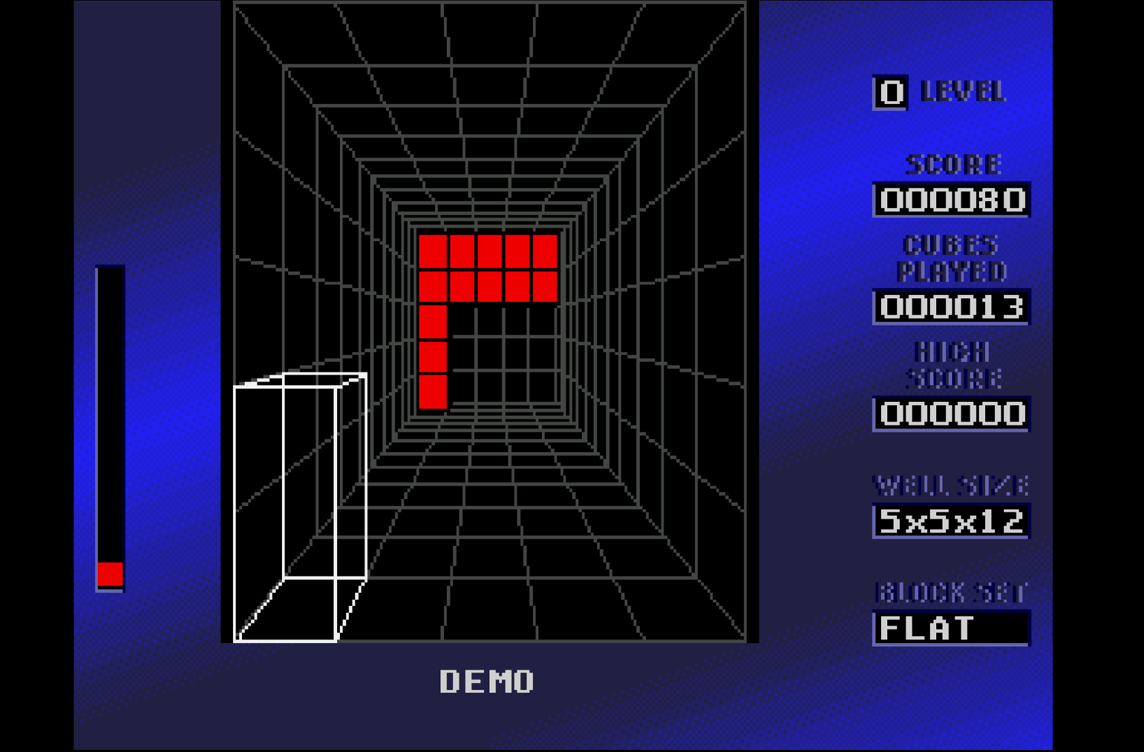- A Paradigm Shift: Tetris in 3D
- Diverse Play Styles for Every Player
- A Strategy for Success: Keeping it Grounded
- Blockout: A Dichotomy of Time
- Controls: A Hurdle to Mastery
- In Retrospect: Novelty vs. Brilliance
- Visuals and Audio: A Visual Spectrum
- Conclusion: A Game of Unfulfilled Promise
- Play Blockout Blockout Anywhere
Blockout, unveiled in 1991, brought a novel twist to the gaming world. It offered a 3D rendition of the beloved classic, Tetris. Unlike its 2D predecessor, Blockout challenged players to think in layers and depth, revolutionizing the way gamers approached this familiar puzzle.
A Paradigm Shift: Tetris in 3D
The essence of Blockout lies in maneuvering various geometric shapes, reminiscent of Tetris pieces, within a three-dimensional well. This departure from the traditional two-dimensional grid demanded a fresh perspective and a heightened spatial awareness.
The objective remained consistent with Tetris: assemble complete layers to clear them, paving the way for subsequent maneuvers.
Diverse Play Styles for Every Player
The game catered to a spectrum of preferences, offering a menu of play styles. The default option presented a flat, conventional playing field. In addition, three distinct modes awaited intrepid players. ‘3D Crazy’ introduced a narrow well, creating a more challenging spatial dynamic.
‘Out of Control‘ elevated the difficulty with intricate shapes and a moderate well size. For those seeking ultimate control, ‘Custom Mode’ allowed fine-tuning of the well’s dimensions and the available piece set, providing a tailored experience.

A Strategy for Success: Keeping it Grounded
Within the enigmatic depths of the 3D well, a prudent approach emerged – keep the pieces grounded. Placing them flatly at the well’s base minimized the guesswork involved in discerning gaps. This strategy mitigated the inherent challenge of a three-dimensional space.
Continuously filling the bottom layer became the focal point, a pragmatic choice amidst the game’s complexity. Attempting to construct multiple layers often proved superfluous, potentially introducing unnecessary complications.
Blockout: A Dichotomy of Time
The experience of Blockout is a study in contrasts. It manages to be both succinct and protracted. While it’s possible to complete all modes within an hour, the process of layering or rectifying mistakes can be a time-intensive endeavor. However, Blockout stumbles in terms of features.
The gameplay, while initially engaging, can grow monotonous over time. Once the novelty fades, the game’s appeal wanes, revealing its limitations.
Mastering Dimensions, One Layer at a Time.
Controls: A Hurdle to Mastery
Control irregularities are a stumbling block in Blockout’s otherwise engaging gameplay. At times, a piece’s movement may falter, or it might overshoot its intended placement. This quirkiness intensifies as the pace quickens, potentially resulting in costly missteps.
It raises the question of whether Tetris truly translates seamlessly to the third dimension, a question answered differently in subsequent adaptations like Tetrisphere.
In Retrospect: Novelty vs. Brilliance
Blockout’s concept, while intriguing, faces execution hurdles. Its brevity and occasional tedium undercut its potential. The absence of substantial features diminishes its replay value. Despite its novelty, Blockout ultimately falls short of brilliance.
Visuals and Audio: A Visual Spectrum
Graphically, this game presents a mixed bag. The color palette aids in distinguishing layers in an otherwise visually challenging game. However, the graphics remain unremarkable, lacking the finesse one might expect from a three-dimensional experience.
Menu interfaces are serviceable, albeit with muted colors. The audio, regrettably, is a weak point. While a few jingles punctuate gameplay, they are sparse. In-game levels lack a musical backdrop, contributing to a somewhat stark auditory experience. Blockout’s presentation is functional but falls short of leaving a lasting impression.

Conclusion: A Game of Unfulfilled Promise
The game, while ambitious in its three-dimensional approach to Tetris, ultimately fails to deliver on its potential. It grapples with brevity and repetition, offsetting its unique premise.
The absence of robust features and control quirks further impede the experience. While it remains a relic of gaming history, this game is a reminder that innovation doesn’t always equate to enduring success.
Play Blockout Blockout Anywhere
Embrace the challenge of Blockout on our website, accessible across various platforms including mobile devices and tablets. Engage in a three-dimensional puzzle-solving adventure wherever you go!